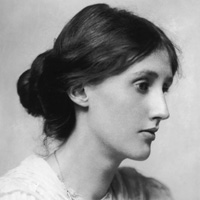Virginia Woolf - Biography and Works
Virginia Woolf was the daughter of the eminent Victorian critic and scholar, Sir Leslie Stephen and Julia Stephen, and was one of the great women writers of the 20th century. She occupies a position of importance in 20th century fiction, for she gave to the stream of consciousness novel a new twist which James Joyce had not been able to impart to it. Though her brothers were sent to school, she was taught at home in English Classic and Victorian literature.

Virginia Woolf (1882-1941)
Virginia's mother died in 1895 and it was the time she had her first mental breakdown. She studied in King’s College majoring classics and history from 1897 to 1901. With her father’s encouragement to be a writer, she had started writing as a career since 1900. Her father’s death in 1905 made her shift from Kensington to Bloomsbury. In Bloomsbury, she along with her brothers and sisters, opened a literary group called Bloomsbury Group. She married to Leonard Woolf in 1912 and established Hogarth Press. She suffered from mental breakdown in her life many times and tried suicide too. Finally, she committed suicide by drowning herself in the river in 1941.
The first novel of significance by Virginia Woolf was The Voyage Out (1915) followed by Night and Day (1919). In these works she made a study of the inner lives of men and women. These first fruits of her genius are remarkable for the mysterious intensity with which she brought out the souls of her characters like Rachel Vinrace and Katherine Hilbert. Jacob's Room (1922) exhibits a fuller advance into maturity. It is the first novel in which her personal vision of the flowing nature of all experience is given full and complete expression. The novel sets forth the impression of Jacob Flanders about his own life as a student at Cambridge, as a young man in love and as a soldier in war. Though the flowing nature of consciousness and the reality of the life of the spirit are nicely brought out in Jacob's Room, yet the novel suffers from lack of unity and cogency of impression.
Mrs. Dalloway (1925) exhibits a further advance in her art of suggesting impressions in a loose and scattered manner. There is no attempt at organized story telling in this novel. All that we have is "a most carefully selected and fully harmonized picture of life in London on one summer's day in 1919". The impressions of Mrs. Dalloway are represented lyrically in this novel, though in her musings there is a streak of sadness. The book opens with Mrs. Dalloway going out to buy flowers for a party and closes with a description of the party, but within these limits the most complex and fascinating pattern of human experience is woven. It is composed of daydreams, memories, and immediate impressions of this central character, enriched by transition into the consciousness of other characters who are connected with Mrs. Dalloway in some emotional or even merely passing relationship. Mrs. Dalloway was followed by To the Light House (1927) which is considered the best novel of this celebrated artist. This novel is divided into three parts. Part I "The Windows", Part II "Time Passes", Part III "The Light House". The experiences of Professor Ramsay and his wife on a holiday are presented graphically. "Mrs. Ramsay is seen not merely as the selfless center of her existence, but as the focus of concentric series existences or less intimately involved with her".
The Waves (1931) sets the technique of the flow of consciousness and inner thought in a heightened tone and is a high watermark of Mrs. Virginia Woolf’s experimentation. Concerned from the beginning with the nature and convinced of its fluid formlessness, she suggested here that personality has no existence apart from the society in which it develops, that the so called individual existence is really no more than a facet of the existence of a group. She illustrated this conception of personality into The Waves by presenting the lives of a closely knit group of seven characters in a series of poetically stylized dialogues or interior monologues. The basic unity under the appearance of diversity is emphasized by the fact that all the characters express themselves in the same style, a highly imagistic, a deeply rhythmical utterance that is constantly on the verge of becoming poetry. The least easily approached of Mrs. Woolf’s novels is also her most brilliant and original creation. The Years (1937) shows a return to the style and method of Mrs. Dalloway and To the Light House. Orlanbdo (1928) takes us to the Elizabethan days and stretches time to include almost eternity.
A.C. Ward describes the books of Virginia Woolf as "exasperatingly shapeless". He regards her books as "snippets cut from a number of cinematography, films and indiscriminately joined up". But as compared to the works of James Joyce, the novels of Virginia Woolf have a form and a shape of their own. They are lucid and luminous, though they may be disjointed in this impressionistic presentation of life.
Published on 6 July 2018 by Kedar Nath Sharma
